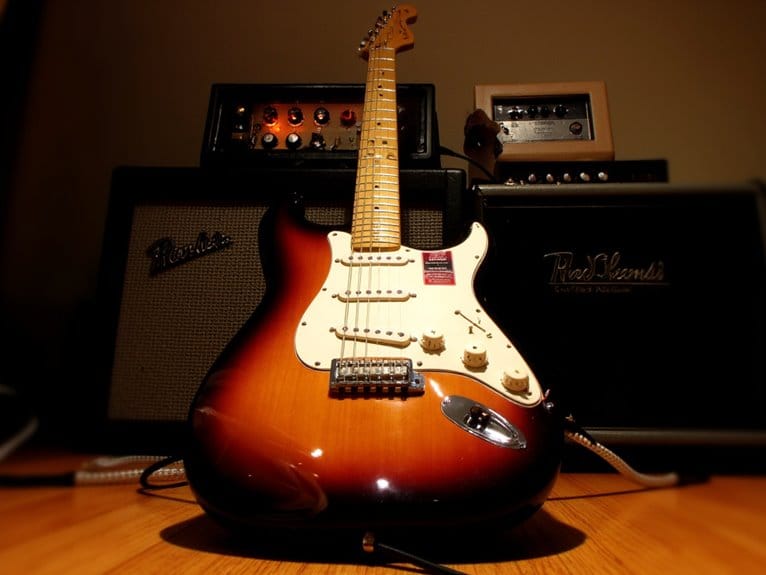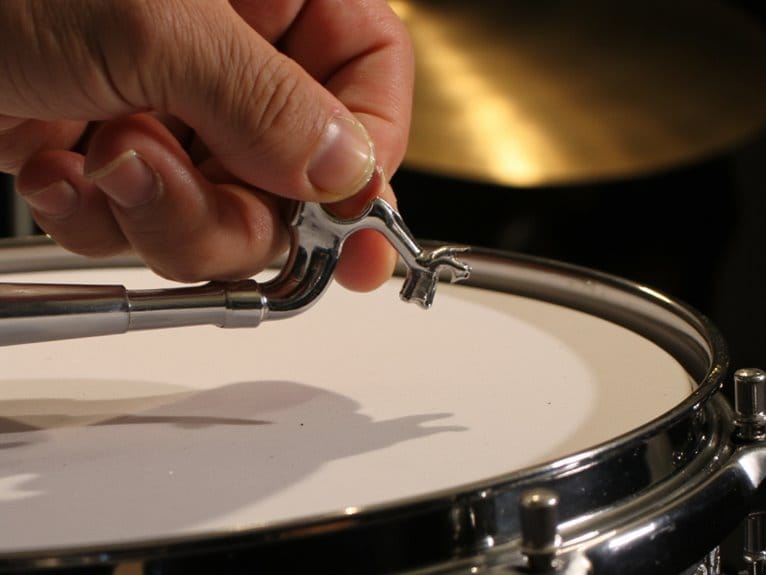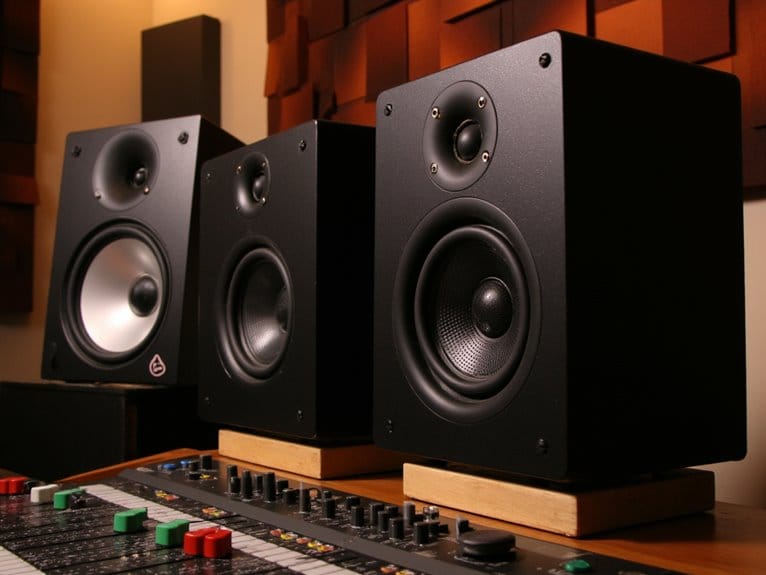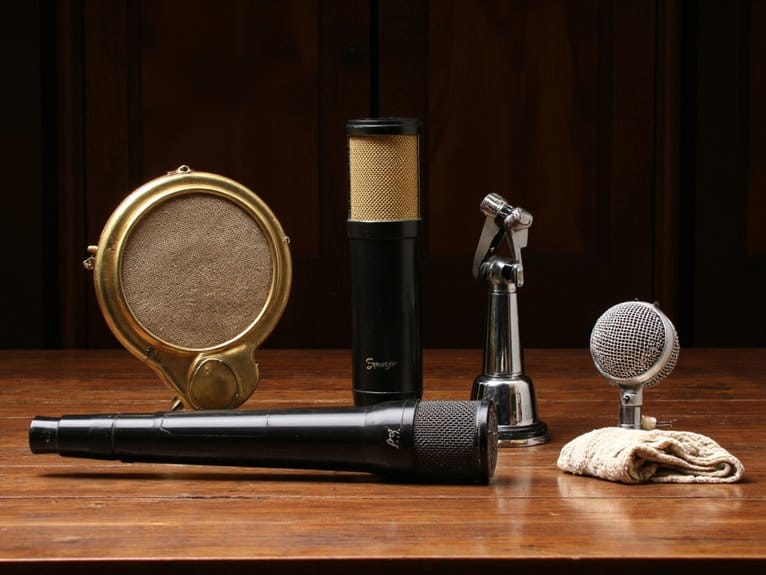Matching Guitar Amplifiers to Your Guitar and Playing Style
Matching your guitar to the right amplifier requires understanding how pickup types interact with different amp technologies-single-coils need clean, transparent amps for bright articulation, while humbuckers perform better with midrange-focused circuits and smooth overdrive. Your playing style determines essential features: metal demands high-gain circuitry, jazz requires exceptional clean headroom, and active pickups need amps with sufficient input handling to prevent clipping. The perfect pairing reveals tonal possibilities you’ve never experienced.
We are supported by our audience. When you purchase through links on our site, we may earn an affiliate commission, at no extra cost for you. Learn more.
Notable Insights
- Single-coil pickups need clean, transparent amplifiers while humbuckers perform better with midrange-emphasizing amps and smooth overdrive.
- Active pickups require high headroom amplifiers to prevent clipping, while passive pickups benefit from high input impedance designs.
- Metal players need high-gain circuitry for saturation, while jazz guitarists require exceptional clean headroom for note clarity.
- Performance environment determines wattage needs: under 20 watts for home practice, 30-50 watts for live performances.
- Consider guitar type, playing style, wattage requirements, tonal preferences, and portability needs when selecting amplifiers.
Understanding Different Amplifier Technologies and Their Sonic Characteristics
When you’re standing in a music store surrounded by rows of amplifiers, each promising to release your guitar’s true potential, understanding the fundamental differences between amplifier technologies becomes your most valuable tool for making an informed decision. Each type of amplifier has its unique characteristics that can enhance different aspects of your sound. For instance, if you desire a pristine sound without distortion, searching for the best clean amp can significantly elevate your playing experience. Taking the time to explore the sonic qualities of various amplifiers will ensure you find the perfect match for your musical style.
Tube amplifiers deliver that coveted tube warmness through vacuum tubes, creating rich harmonics and natural compression that blues and jazz players cherish, though they require more maintenance and careful transport.
Solid-state amps offer solid state reliability with transistor circuits, providing consistent performance and durability that touring musicians depend on, especially for high-gain applications. Higher wattage results in greater volume output, where tube amps have higher perceived volume than solid-state or modeling amps.
Modeling amplifiers bring modeling versatility through digital emulation, cramming multiple amp types and effects into one affordable package. These amps serve as a cost-effective alternative for accessing vintage tones without needing to invest in multiple expensive amplifiers. Professional musicians often prioritize driver stability when selecting digital modeling systems for consistent performance during recording sessions and live performances. Additionally, many modeling amplifiers have settings that allow users to tailor their sound to specific genres, making them suitable for various musical styles. When searching for the best clean amp, musicians can easily find options that replicate the pristine, undistorted tones of classic tube amplifiers, making them an invaluable tool for both practice and performance. This level of customization not only enhances creativity but also ensures that players can achieve their desired sound with confidence.
Hybrid designs achieve hybrid balance by pairing tube preamps with solid-state power sections, offering warmth without full tube complexity. The amplifier technology you choose directly impacts how your guitar pickups translate their signal, particularly when using single coil pickups that excel in clarity and precise sound reproduction across various musical genres.
Pairing Pickup Types With Compatible Amplifier Systems
While understanding amplifier technologies gives you the foundation for making smart gear choices, the real magic happens when you pair your guitar’s pickups with the right amplifier system. This creates a symbiotic relationship that can either elevate your tone to professional heights or leave you scratching your head wondering why everything sounds muddy or harsh.
Pickup compatibility isn’t just about plugging in and hoping for the best-it’s about understanding how your guitar’s magnetic personalities interact with your amplifier’s electronic characteristics. Single-coils demand clean, transparent amplifiers that won’t muddy their bright articulation, while humbuckers thrive through amplifiers with robust midrange emphasis and smooth overdrive capabilities.
Understanding your guitar’s magnetic DNA and how it speaks to your amplifier’s circuitry separates amateur tone-chasing from professional sound crafting.
- Active pickups require amplifiers with high headroom to handle their consistent hot output without unwanted clipping.
- Passive pickups need high input impedance amplifiers (around 1 MΩ) to preserve their natural tone.
- Effective tone shaping matches pickup resonant frequencies with appropriate amplifier EQ settings.
Stratocasters with their signature single-coil pickups particularly benefit from amplifiers with dual-channel design that allow seamless switching between pristine clean tones and warm overdrive characteristics. Similar to how frequency response ranges of 20 Hz to 20 kHz ensure optimal audio spectrum coverage in professional headphone systems, guitar amplifiers must accommodate the full frequency output of your pickups to maintain tonal integrity.
Essential Amplifier Features for Genre-Specific Playing Styles
Your amplifier’s gain structure becomes the foundation that either supports or sabotages your genre-specific sound, with metal players requiring robust high-gain circuitry that can push into aggressive saturation territory, while jazz guitarists need exceptional clean headroom that preserves note clarity and harmonic complexity without unwanted breakup.
I’ve found that understanding these polar opposite requirements helps you identify whether you’re shopping for an amp that excels in one direction or compromises across multiple styles.
The gain control isn’t just a volume knob with attitude-it’s the primary tool that shapes your guitar’s voice, determining whether you’ll achieve crushing metal distortion or pristine jazz chord voicings that shimmer with crystalline definition.
Complementing your gain structure, features like 3-band EQ controls allow you to fine-tune your sound by adjusting bass, midrange, and treble frequencies to match your specific playing style and genre requirements. Quality amplifiers maintain sound integrity with a typical frequency response range of 40Hz to 20kHz, ensuring clarity across the full spectrum of musical frequencies.
Gain Control for Metal
Metal guitarists know that achieving the perfect crushing tone starts with mastering your amplifier’s gain control, which serves as the foundation for the aggressive, saturated sound that defines the genre.
I’ve found that starting around mid-level settings (5-6) provides enough gain saturation without sacrificing note definition, though most metal applications require pushing into the 7-10 range for proper heaviness.
The key lies in balancing distortion with clarity, since excessive gain creates muddiness that’ll bury your riffs in the mix. Your amp’s dynamic response becomes essential here, allowing picking intensity to shine through even under heavy saturation.
- Combine amp gain with overdrive pedals for tighter, more controlled distortion
- Adjust EQ after setting gain to prevent boominess or excessive shrillness
- Consider your pickup output when dialing in gain levels
Clean Headroom for Jazz
When jazz demands pristine clarity and articulate note definition, I’ve learned that clean headroom becomes your amplifier’s most essential specification, determining how loud you can play before unwanted distortion creeps into your warm, hollow-body tone.
You’ll want moderate wattage amps between 15-50 watts, which balance portability with sufficient headroom for most venues, though I’ve found higher wattage necessary for larger ensembles.
Clean dynamics require amplifiers voiced for clarity rather than gain-staging, typically featuring tubes like 6L6 or KT88 that maintain warmth without early breakup. Tube amplifiers excel in delivering organic and dynamic clean tones that respond naturally to your playing touch.
Your pickup choice considerably affects this equation-lower output humbuckers or flatwound single-coils preserve headroom better than high-output alternatives.
Proper tonal balance emerges when you match your guitar’s output characteristics with an amplifier’s clean threshold, ensuring expressive phrasing without unwanted compression.
For optimal jazz performance, prioritize amplifiers with 3-band EQ systems that allow precise frequency shaping to enhance the natural voice of your guitar while maintaining the crystalline clarity essential for melodic nuance.
Technical Specifications That Shape Your Guitar’s Voice
While many guitarists focus primarily on their instrument’s wood, pickups, and strings, I’ve learned through years of playing that your amplifier’s technical specifications often play an equally essential role in defining your overall sound. Your amp’s preamp circuits determine how your guitar’s signal gets shaped and colored before reaching the power stage, while speaker configurations directly affect how those carefully crafted tones translate into actual sound waves.
Understanding these technical relationships helps you make informed decisions:
- Impedance matching between your amp and speakers prevents damage while optimizing tonal clarity
- Wattage ratings don’t scale linearly with volume-100 watts isn’t twice as loud as 50 watts
- Pickup output levels interact differently with various preamp designs, affecting distortion characteristics and overall responsiveness
The choice between tube vs. solid-state technology fundamentally alters how your guitar’s signal responds, with tube amplifiers providing natural compression and harmonic saturation that many players find essential for blues and rock tones. Just as guitarists are discovering that professional sound can be achieved with budget equipment, many amp manufacturers now offer high-quality preamp circuits at accessible price points.
Choosing the Right Amplifier for Your Performance Environment
Your performance environment fundamentally determines which amplifier specifications matter most, since a 15-watt tube amp that sounds perfect in your bedroom will disappear completely in a large venue filled with drums and bass.
I’ve learned through countless gigs that choosing between home practice and live performance scenarios requires balancing three critical factors: the wattage needed for adequate volume, the portability you can realistically manage, and the tonal flexibility required across different acoustic spaces.
Whether you’re practicing quietly at home or projecting sound across a crowded club, understanding these power and portability trade-offs will save you from hauling unnecessarily heavy gear or discovering your amp can’t compete with the rest of the band. Just as professional recording setups require careful matching of components with appropriate gain capabilities to capture optimal sound quality, your amplifier choice must align with your specific performance demands.
For apartment dwellers specifically, 5-10 watt amplifiers with headphone jacks provide the ideal solution for maintaining neighbor-friendly practice sessions while still delivering adequate tone and volume for personal use.
Home Vs Live Settings
Choosing an amplifier that performs well in both your living room and on stage represents one of the most challenging decisions you’ll face as a guitarist, since the acoustic demands of these environments differ dramatically in ways that directly impact your tone, volume requirements, and overall playing experience.
For home amplification, you’ll want something under 20 watts with manageable volume levels, while live performance demands 30-50 watts to compete with drums and fill venues effectively.
The key differences between these settings include:
- Sound projection: Stage amps need omnidirectional dispersion to fill physical space, while home amps focus on direct, controlled output.
- Tonal flexibility: Live environments benefit from microphone placement options, whereas home settings rely primarily on amp controls.
- Portability considerations: Home amps prioritize compactness, while gig rigs require scalable speaker configurations and setup complexity.
Modern amplifiers like the Fender Rumble series bridge this gap effectively, with models offering built-in overdrive circuits that allow seamless switching between clean home practice tones and the gritty sounds needed for live performance.
For budget-conscious players, amps in the $100 to $300 range provide solid sound quality without excessive costs, making them ideal for musicians who need versatility across different performance environments.
Power and Portability Needs
The wattage rating on your amplifier’s nameplate tells only part of the story when it comes to actual volume output, and I’ve seen countless guitarists make expensive mistakes by assuming that more watts automatically equals dramatically louder sound.
Smart wattage selection requires understanding that doubling power only increases volume by 3 dB, which your ears barely notice, while achieving twice the perceived loudness demands ten times more power.
For bedroom practice and recording, 10-18 watts provides surprising volume without disturbing neighbors, though you’ll struggle against drummers without microphones.
Mid-range 20-45 watt amps excel in clubs where effective volume management balances clean headroom with desirable tube saturation. Many amplifiers in this range feature power reduction circuits that allow you to achieve tube saturation at lower volume levels for greater venue flexibility.
High-wattage options of 50+ watts suit larger venues but sacrifice portability for headroom you might never utilize.
Remember that speaker size also significantly impacts your amp’s sound character and overall performance, with 10-inch speakers delivering fuller, more robust tone compared to smaller 6-inch models that prioritize portability over depth.
Balancing Budget Considerations With Long-Term Investment Value
When you’re staring down a wall of amplifiers at the music store, wrestling with sticker shock while your wallet whispers sweet nothings about ramen dinners, I’ve learned that smart amp shopping isn’t just about finding the cheapest option that doesn’t sound like a dying robot.
Your investment willingness should factor in value depreciation patterns, because that $300 modeling amp might lose half its worth faster than my motivation on Monday mornings.
Consider these long-term value factors:
- Tube amps from legacy brands like Marshall and Fender typically retain 60-70% of their value
- Modeling amps offer immediate versatility but depreciate 40-50% within two years
- Higher upfront investment in reputable brands often yields better total cost of ownership
Budget allocation becomes strategic when you balance immediate needs against future resale potential. Quality construction with strong materials and metal chassis translates directly to longevity, making these amplifiers better investments that endure the wear and tear of regular gigging and transport. Orange amplifiers exemplify this principle, with models consistently achieving 4.5 stars or above for their exceptional sound-to-price ratios.
Frequently Asked Questions
What’s the Difference Between Amp Modeling and Profiling Technology?
Amp modeling uses digital algorithms to simulate various amplifier types with broad flexibility, while profiling technology captures exact tonal responses from specific physical amps, creating precise digital snapshots of real amplifiers.
Should I Buy a Used Tube Amplifier or New Solid-State?
You’ll find used tube advantages include vintage warmth and character, but consider maintenance costs. Solid state benefits offer reliability, consistency, and lower prices. Choose based on your budget, genre preferences, and willingness to handle tube upkeep.
On a final note
Finding the perfect amplifier match isn’t about chasing the most expensive gear-it’s about understanding how your guitar’s pickups, your musical style, and your playing environment work together. You’ve got the knowledge now to make informed decisions that’ll serve you for years. Trust your ears, consider your budget, and remember that the best amp is simply the one that makes you want to keep playing.







